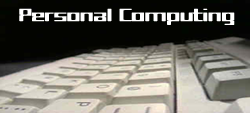 By Reid Goldsborough
By Reid Goldsborough
The one constant about personal computers is change, and the one PC technology that has changed the most is storage devices. The first IBM PC in 1981 came with one or two 160-kilobyte floppy drives. Following the lead of Apple’s first iMac in 1998, most of today’s PCs dispense with floppies altogether.
Various technologies have vied to replace the venerable, but slow and low-capacity, floppy drive, from Zip drives to rewritable CD and DVD drives. The most versatile is the USB flash drive, first used by IBM in 1998 on its ThinkPad laptop computers in sizes from 8 to 64 megabytes.
Flash drives are available today in sizes all the way up to a whopping 64 gigabytes, with Kanguru Solutions’ Kanguru Flash Drive Max costing an equally whopping $2800 (www.kanguru.com/flashdrive_max.html). The sweet spot is the 1-gigabyte drives, which generally cost from $45 to $90. A step up, Kingston’s 2-gigabyte U3 Data Traveler can be had for $80 (www.kingston.com/flash). Smaller 128-megabyte drives cost as little as about $10 today. Other popular vendors include Verbatim (www.verbatim.com), Memorex (www.memorex.com), and SanDisk (www.sandisk.com).
Flash drives can be used for everything floppy drives used to be used for and then some. You can use them as part of a “sneaker net” to move files by walking the drive from one PC to another, which can be convenient for very large files. You can back up important files to them for safekeeping. You can run programs off the flash drive, bringing in your own Web browser or office suite to work or to an Internet cafe. You can create an emergency drive in case your PC is compromised by a virus or hard disk crash.
A USB flash drive plugs into a computer’s USB, or universal serial bus, port, available on computers made over the past five years or so. If you’re running a newer version of Windows or the Mac operating system, your computer will recognize the flash drive just by plugging it in and will automatically assign a letter to it just as with your hard drive and CD or DVD drive. If you’re running an older operating system such as Windows 98, Windows NT, or Mac OS 8, you may need to download a software driver (typically not available for Windows 95).
Flash drives come with a USB 2.0 or 1.1 interface. The newer USB 2.0 drives can be used with computers that have older USB 1.1 interfaces, only they’ll run slower.
They’re called flash drives because they use flash memory, which is a hybrid between random-access memory (RAM) and hard drive storage. Like RAM, it’s lighting fast (the “flash” name was coined by Toshiba to convey speed). Like a hard drive, data is retained when power is no longer being supplied.
USB flash drives go by other names as well, including thumb drives, key drives, keychain drives, memory keys, pen drives, chip sticks, USB keys, USB sticks, and memory sticks, among others. Sometimes the term USB drive is used to refer to a larger but still portable conventional hard drive that plugs into the computer’s USB port, two examples being Maxtor’s OneTouch III Mini Edition (www.maxtorsolutions.com) and Pexagon Technology’s Store-It Drive (www.pexagontech.com/store-it).
USB flash drives are typically in the shape of a fat stick of chewing gum, but they can take other forms as well, including a pen that writes. You can slip one into your pocket or pocketbook, attach one to a keychain, or fasten one to a cord and wear it around your neck as a geeky fashion statement.
Flash drives are hardier than floppy disks, hard drives, and rewritable CD and DVD discs, better able to withstand scratches, dust, drops, and spills. They’re faster and more durable than rewritable CD and DVD discs, rated for far more write/erase cycles.
One negative, however, stems from their versatility and convenience. They can be a security risk, giving insider thieves the capability of smuggling large amounts of data ouwt of an organization undetected and malcontents the capability of manually installing malicious software on a network. This is the reason that some corporations and government agencies have banned their use or disabled their mounting by ordinary users, a feature introduced in Windows XP Service Pack 2. Other organizations have disconnected USB ports inside their computers. There are even reports of some organizations filling USB sockets with epoxy.
All this is unfortunate. USB flash drives are a useful technology — high-capacity, fast, durable, and compact — an example of PC innovation at its finest.
♦

